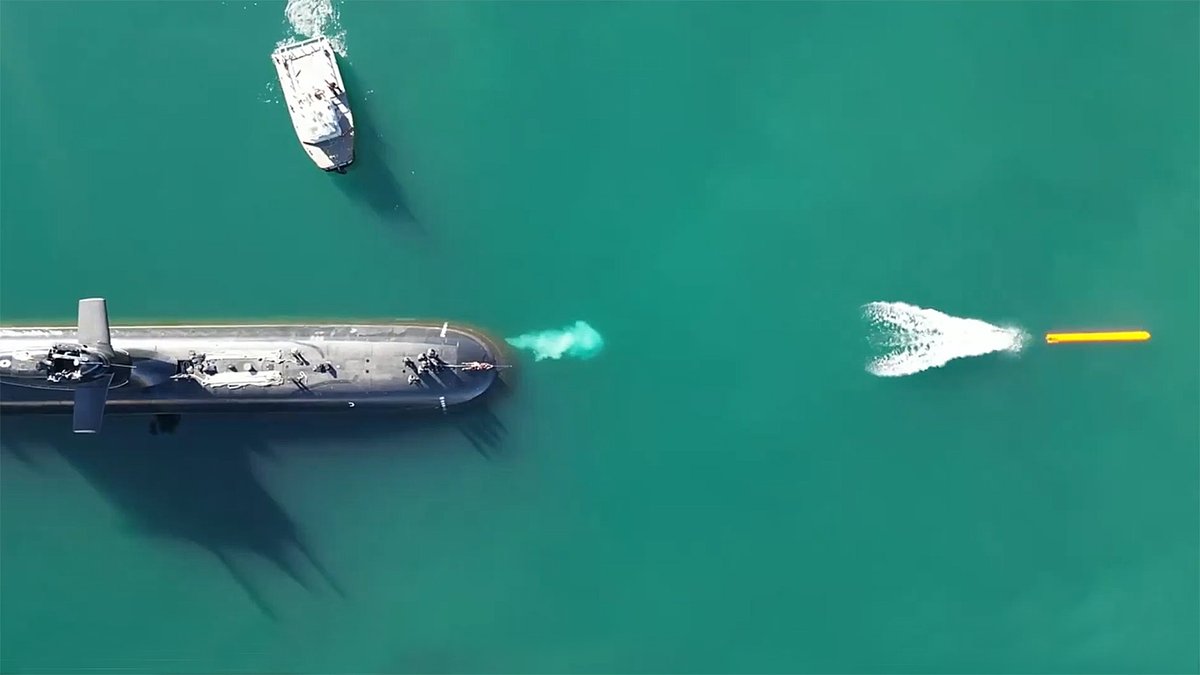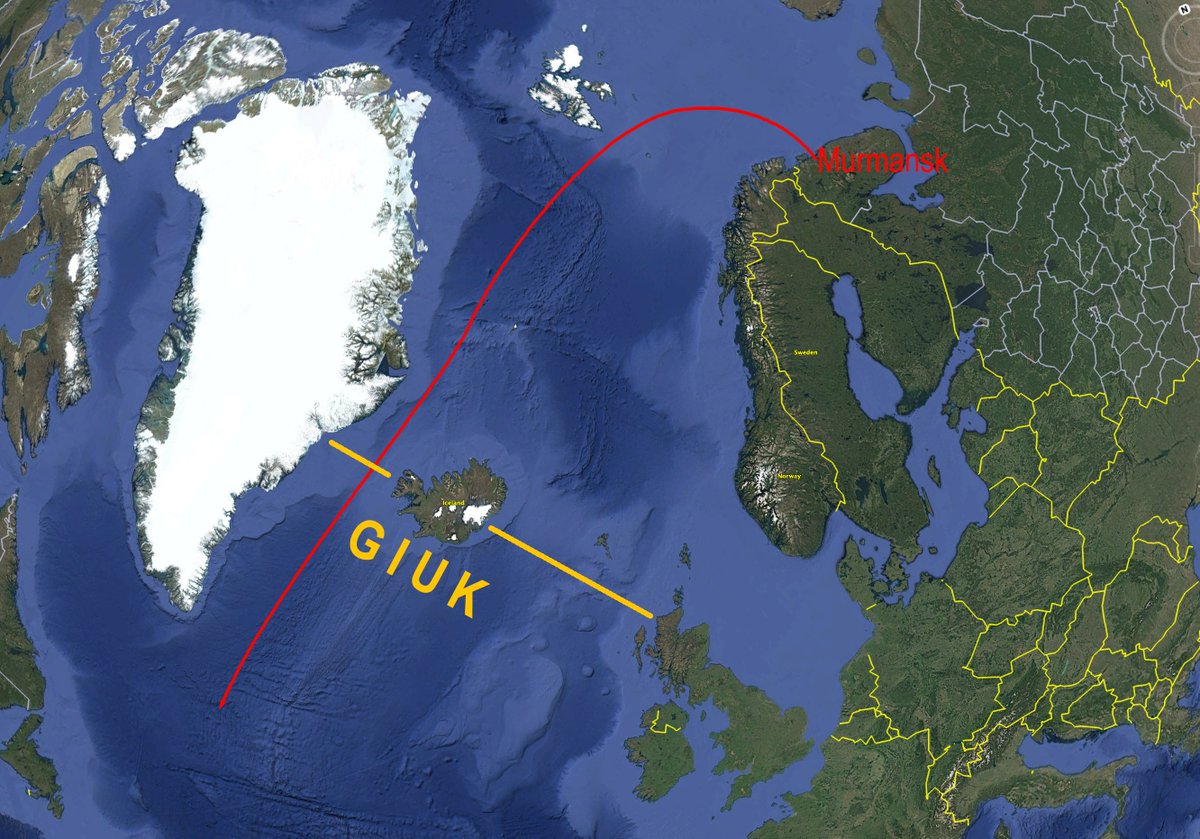This is the North Atlantic Ocean.
The ocean that both, the US and Europe, need to be free of hostile submarines. Chinese and russian submarines can only enter it by six routes. Three of which are impassable for them.
But the easiest & shortest open route is past Greenland.
1/25
The ocean that both, the US and Europe, need to be free of hostile submarines. Chinese and russian submarines can only enter it by six routes. Three of which are impassable for them.
But the easiest & shortest open route is past Greenland.
1/25

During WWI German submarines sank 6,000+ allied ships and during WWII 3,500+ allied ships.
In both wars the allies had to deploy 100s of destroyers, corvettes, subchasers and aircraft to hunt Germany's U-Boote.
(Photo: a U-Boot is hit by a US Navy plane on 16 July 1943)
2/n
In both wars the allies had to deploy 100s of destroyers, corvettes, subchasers and aircraft to hunt Germany's U-Boote.
(Photo: a U-Boot is hit by a US Navy plane on 16 July 1943)
2/n

During the Cold War NATO had two military commands:
• Supreme Allied Commander Europe (SACEUR) for the defence of Europe
• Supreme Allied Commander Atlantic (SACLANT) for the defence of the Atlantic
Map: SACLANT area & subcommands:
🇬🇧 EASTLANT
🇺🇸/🇨🇦 WESTLANT
🇵🇹 IBERLANT)
3/n
• Supreme Allied Commander Europe (SACEUR) for the defence of Europe
• Supreme Allied Commander Atlantic (SACLANT) for the defence of the Atlantic
Map: SACLANT area & subcommands:
🇬🇧 EASTLANT
🇺🇸/🇨🇦 WESTLANT
🇵🇹 IBERLANT)
3/n

Keeping the Atlantic free of Soviet submarines was essential to quickly ship American and Canadian reinforcements and supplies to Europe.
The main battlefield of this Atlantic campaign would have been the NORLANT subcommand, which was commanded by a Royal Navy admiral, who
4/n
The main battlefield of this Atlantic campaign would have been the NORLANT subcommand, which was commanded by a Royal Navy admiral, who
4/n

was also responsible for the NORECHAN subcommand. NORLANT was tasked to prevent the Soviet Northern Fleet from passing through the Greenland-Iceland-UK (GIUK) gap, while NORECHAN was tasked with preventing Soviet ships from entering the North Sea.
5/n
5/n

In both subcommands the British Royal Navy provided the bulk of ships, submarines and aircraft, with US Navy forces supporting it in NORLANT, and Royal Norwegian Navy, German Navy and Royal Netherlands Navy forces supporting it in NORECHAN.
Even though Greenland is a Danish
6/n
Even though Greenland is a Danish
6/n

territory, Denmark contributed no ships or aircraft to the defence of the GIUK gap, as the Danish Armed Forces (supported by German forces and Royal Norwegian ships & aircraft) were tasked blocking the Danish Straits to the Soviet Baltic Fleet, East German Navy & Polish Navy.
7/n
7/n

After the Cold War SACLANT's command structure was abolished and on 19 June 2003 SACLANT ceased to exist.
Due to russia's growing aggressiveness NATO formed the Joint Force Command (JFC) Norfolk on 26 July 2019. JFC Norfolk is responsible for defence of the Atlantic and its
8/n
Due to russia's growing aggressiveness NATO formed the Joint Force Command (JFC) Norfolk on 26 July 2019. JFC Norfolk is responsible for defence of the Atlantic and its
8/n

commander double-hats as the commander of the US Navy's Second Fleet.
When JFC Norfolk was formed the main threat were russian nuclear attack submarines, but since 2022 China puts a new nuclear attack submarine into the water every 4 months.
9/n
When JFC Norfolk was formed the main threat were russian nuclear attack submarines, but since 2022 China puts a new nuclear attack submarine into the water every 4 months.
9/n
https://x.com/noclador/status/1884709653130490039
Therefore NATO now also has to defend against Chinese submarines, which in theory could enter the Atlantic by six routes:
• Panama Canal
• Suez Canal (and Mediterranean Sea)
• Northwest Passage
• Northeast Passage
• around Cape of Good Hope
• around Cape Horn
10/n
• Panama Canal
• Suez Canal (and Mediterranean Sea)
• Northwest Passage
• Northeast Passage
• around Cape of Good Hope
• around Cape Horn
10/n
However the first two of these are impassable for Chinese submarines, as submarines have to transit the Panama and Suez canals surfaced.
This means that every US Atlantic Fleet submarine would lie in wait on the Panama Canal's Atlantic side, while Turkish, Greek, Italian,
11/n

This means that every US Atlantic Fleet submarine would lie in wait on the Panama Canal's Atlantic side, while Turkish, Greek, Italian,
11/n


French and Spanish submarines would lie in wait on the Suez Canal's Mediterranean side.
The NATO submarines would then shadow the Chinese subs, up to the moment China starts a war: then each Chinese sub would immediately eat two torpedoes.
(Photo: a Spanish torpedo test)
12/n
The NATO submarines would then shadow the Chinese subs, up to the moment China starts a war: then each Chinese sub would immediately eat two torpedoes.
(Photo: a Spanish torpedo test)
12/n

The Northwest Passage through Canada's Arctic is also impassable for Chinese subs.
Not because of anything Canada's underfunded armed forces could do, but because the US Navy would mine the Parry Channel (red), especially the shallow Barrow Strait (yellow), extensively,
13/n
Not because of anything Canada's underfunded armed forces could do, but because the US Navy would mine the Parry Channel (red), especially the shallow Barrow Strait (yellow), extensively,
13/n

while attack submarines would patrol the exits of Parry Channel and Nares Strait (purple, between Ellesmere Island and Greenland).
Furthermore US Navy P-8 Poseidon Maritime Patrol Planes flying tom Pituffik Space Base (the former Thule Air Base) would patrol the ice-free
14/n
Furthermore US Navy P-8 Poseidon Maritime Patrol Planes flying tom Pituffik Space Base (the former Thule Air Base) would patrol the ice-free
14/n
parts of Baffin Bay.
Btw. the Arctic ice pack is not a problem for submarines as they operate far below the ice.
A lack of bathymetric data about the channels of Canada's Arctic Archipelago also prevents Chinese submarines from passing through Canada's territorial waters.
15/n
Btw. the Arctic ice pack is not a problem for submarines as they operate far below the ice.
A lack of bathymetric data about the channels of Canada's Arctic Archipelago also prevents Chinese submarines from passing through Canada's territorial waters.
15/n

This leaves the Chinese with three routes into the North Atlantic (measured from Qingdao to New York):
• Northeast Passage - 10,000 nautical miles
• Cape of Good Hope - 16,000 nautical miles
• Cape Horn - 17,000 nautical miles
If the Chinese take the longest route around
16/n
• Northeast Passage - 10,000 nautical miles
• Cape of Good Hope - 16,000 nautical miles
• Cape Horn - 17,000 nautical miles
If the Chinese take the longest route around
16/n
Cape Horn, then they would have to pass through the 450 nautical miles wide Drake Passage between Tierra del Fuego and Antarctica.
An ideal spot for US attack submarines to ambush them. Also P-8 Poseidon flying from RAF Mount Pleasant in the Falkland Islands would hunt the
17/n
An ideal spot for US attack submarines to ambush them. Also P-8 Poseidon flying from RAF Mount Pleasant in the Falkland Islands would hunt the
17/n

Chinese submarines. Of course, like the Canadian Armed Forces, also the British Armed forces have none of the equipment to do that and it would fall again to the US Navy to patrol this route into the Atlantic Ocean.
The route around Cape of Good Hope would take Chinese subs
18/
The route around Cape of Good Hope would take Chinese subs
18/
on a complicated route, as the southern parts of the South China Sea and adjacent Java Sea, as well as the straits enter the Indian Ocean (i.e. Malacca, Sunda) are so shallow that the armed forces of Malaysia, Singapore and Indonesia would discover a pack of Chinese subs.
19/n
19/n

And of course, the narrow straits of the Indonesian archipelago would again be ideal ambush sites for US and Australian submarines.
Furthermore crossing the Indian Ocean means to pass by the US base on Diego Garcia, from where P-8 Poseidon patrol the entire Indian Ocean.
20/n
Furthermore crossing the Indian Ocean means to pass by the US base on Diego Garcia, from where P-8 Poseidon patrol the entire Indian Ocean.
20/n

This leaves the Northeast Passage as the shortest and safest route for Chinese submarines into the Atlantic, as for more than half of its course the route runs through russian territorial waters.
Furthermore the only safe harbour for Chinese submarines to load food and ammo
21/n
Furthermore the only safe harbour for Chinese submarines to load food and ammo
21/n

is Murmansk in northern russia (if a Chinese submarine would surface in Cuba or Venezuela during a US-China war, the US would immediately bomb that submarine while it is docked; however the US would not risk to do the same if the submarine is docked in nuclear-armed russia).
22/n
22/n
And all this explains the renewed obsession of US military planners and consequently also the Trump administration with the defence of the GIUK gap.
Unlike the Cold War the Royal Navy is severely depleted, while Denmark, which no longer has to focus on the defence of the
23/n
Unlike the Cold War the Royal Navy is severely depleted, while Denmark, which no longer has to focus on the defence of the
23/n

Danish straits, can also contribute nothing for the defence of Greenland and GIUK gap.
As the US Navy will require every ship in the Pacific to fight the Chinese navy, the lack of anti-submarine frigates, submarines, and maritime patrol aircraft in Europe and Canada, forces
24/n
As the US Navy will require every ship in the Pacific to fight the Chinese navy, the lack of anti-submarine frigates, submarines, and maritime patrol aircraft in Europe and Canada, forces
24/n
the US Navy to divert ships and aircraft to keep the Atlantic safe from Chinese wolf packs.
This lack of European defence preparedness will see Trump clash furiously with European nations (and Canada), which still have a happy-go-lucky attitude to their defence obligations.
25/25
This lack of European defence preparedness will see Trump clash furiously with European nations (and Canada), which still have a happy-go-lucky attitude to their defence obligations.
25/25
• • •
Missing some Tweet in this thread? You can try to
force a refresh























